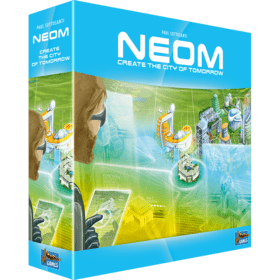Neom
 NEOM - 创建明日之城可让您在三代人的时间内建造自己的未来城市。您需要选择合适的建筑板块来创建美丽的住宅区、商业区和对环保更友好的工业。建造建筑会产生金钱、胜利点数和各类可用于建造新板块的资源。你需要仔细规划你的城市的结构,否则你会在游戏结束时失分——没有人喜欢住在核电站旁边,对吧?
NEOM - 创建明日之城可让您在三代人的时间内建造自己的未来城市。您需要选择合适的建筑板块来创建美丽的住宅区、商业区和对环保更友好的工业。建造建筑会产生金钱、胜利点数和各类可用于建造新板块的资源。你需要仔细规划你的城市的结构,否则你会在游戏结束时失分——没有人喜欢住在核电站旁边,对吧?
Paul Sottosantis NEOM - 创建明日之城是一款适合 10 岁以上,1 - 5 人游玩的桌游中面临的一项艰巨任务。仅仅经过三代人的努力,一座新的城市就应该出现在他们的游戏板上。为了做到这一点,他们每代起草 7 个建筑瓷砖并将它们添加到他们的城市中。但他们必须小心,因为放置瓷砖需要规划和策略。道路网络必须具有功能性,住宅区和工业区不应相邻放置,商业区如果不能从周围环境中受益,其效率就会降低。大约 45 分钟后,游戏结束,一名玩家称自己为建筑师大师。
玩家人数: 1 - 5
游戏时长: 18 mn
复杂度: 2 / 5
在线上玩 Neom 以及 1194 款其他游戏。
无需下载——直接在浏览器上玩.
与您的朋友以及来自世界各地的玩家一起.
免费。

在线上玩 Neom 以及 1194 款其他游戏。
无需下载——直接在浏览器上玩.
与您的朋友以及来自世界各地的玩家一起.
免费。

玩法简介
游戏目标
在《neom》中,你将在三个世代期间通过放置板块来建造未来城市。这些板块提供各种货物、金钱和胜利点。每个城市必须包含特定建筑,否则计分时会扣分。最终胜利点最多的玩家获胜。
游戏流程
游戏进行三个世代(即三轮),起始于预备轮(选择基石板块)。每个世代包含七个回合,整局游戏共21回合。每回合选择板块并执行三种行动之一。21回合后计分定胜负。
进行世代
从第一世代开始,依序进行三个世代。每个世代开始时:
- 分发对应世代的板块
- 每位玩家获得8张手牌
随后进行7个回合,每回合包含: A. 选择板块 B. 执行行动 C. 传递板块
世代结束于第7回合(此时手牌剩2张)。收取城市收入后进入下个世代。第三世代结束后终局计分。
A. 选择板块
所有玩家同时从手牌秘密选择1张板块,其余板块向左传递。
B. 执行行动
通常可选择以下三种行动:
行动:放置选定板块
- 需满足板块左上角要求(若无要求可直接放置)
- 放置规则:
* 必须放在城市网格空格或替换已有板块(详见"替换板块"规则) * 新板块必须通过道路连接至城市中心(若替换了中心则连接新中心) * 禁止旋转板块(文字必须正向阅读)
行动:放置基石板块
- 将选定的世代板块放回游戏盒(不使用)
- 选择一块己方基石板块按上述规则放置
- 重要限制:基石板块数量 ≤ 当前世代数
- 注意:不可用灾难板块换取基石
行动:出售板块换钱
- 将选定板块放回游戏盒(不使用)
- 从公共供应区获得5英镑
- (通常用于资金短缺时)
回合结束:灾难生效
- 若有玩家选择灾难板块,则当前回合结束时对所有其他玩家生效(扣钱或摧毁城市板块)
- 选择灾难的玩家免疫效果但本轮无行动
- 注意:若无人选择灾难,则该世代无灾难
- 防护机制:
* 建造特定公共板块可防火灾和犯罪(洪水无法防护) * 防护板块不计入扣钱计算 * 无法防护强制移除效果
C. 传递板块
从右侧玩家处接收传递的板块,作为下回合手牌。若无板块传递,则当前世代结束。
世代结束:收取收入
- 每世代7回合后,从商业板块(及其他带收入标志的板块)获得收入
- 重要:第三世代结束后也收取收入
终局计分
第三世代收入收取后游戏结束,按以下类别计算胜利点(VP):
板块基础分
累加城市中住宅/公共板块右上角印刷的VP值
社区分
通过道路直接相连的住宅板块形成社区,按社区规模计分:
| 规模 | 1 | 2 | 3 | 4 | 5 | 6 | 7 | 8 | 9 | 10+ |
|---|---|---|---|---|---|---|---|---|---|---|
| VP | 1 | 3 | 6 | 10 | 15 | 21 | 28 | 36 | 40 | 每增1块+4 |
货物分
- 初级货物:1 VP/种
- 加工货物:2 VP/种
- 奢侈货物:10 VP/种
- 注意:只计城市板上方token(同种货物不重复计)
金钱分
每2英镑=1 VP(向下取整)
污染扣分
- 每个住宅板块附近有污染源时扣分:
* 正相邻污染源:扣2 VP * 斜对角污染源:扣1 VP
- (同一污染源可多次扣分)
鬼城扣分
- 无住宅板块:扣10 VP
- 仅1个住宅板块:扣4 VP
电力扣分
无发电板块:扣5 VP
总分与胜负
累加上述分数为最终得分。最高VP者获胜,平局则共享胜利。
变体规则
无灾难模式
- 灾难板块替换为城市板块
- 移除"保险公司"
- 调整计分:
* 消防局:+2 VP * 警察局:+3 VP * 公共安全局:+5 VP
随机灾难模式
- 灾难板块替换为城市板块
- 每世代随机触发一次灾难(影响所有玩家)
单人游戏
| 板块数 | 实习生 | 学徒 | 研究员 | 工长 | 大师 | 总监 |
|---|---|---|---|---|---|---|
| 1+ | 0-79 | 80-99 | 100-109 | 110-119 | 120-124 | 125+ |
| 4+ | 0-84 | 85-104 | 105-114 | 115-124 | 125-129 | 130+ |
| 5+ | 0-89 | 90-109 | 110-119 | 120-129 | 130-134 | 135+ |

